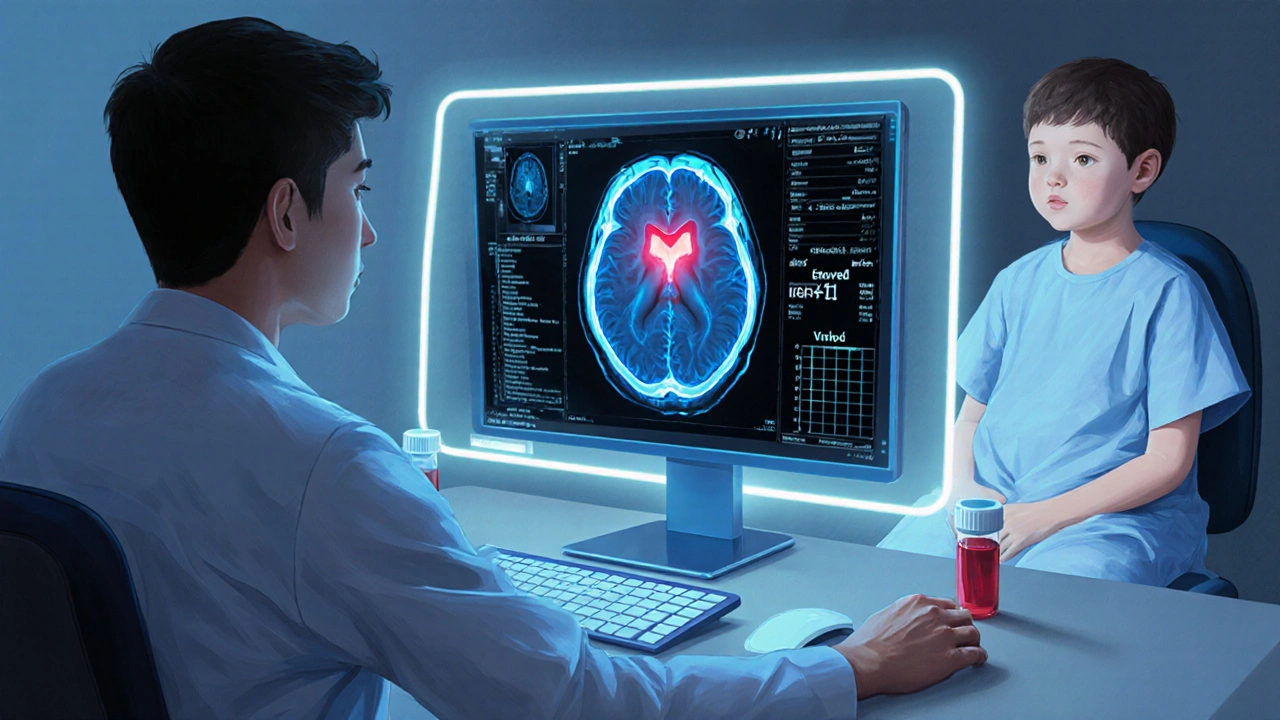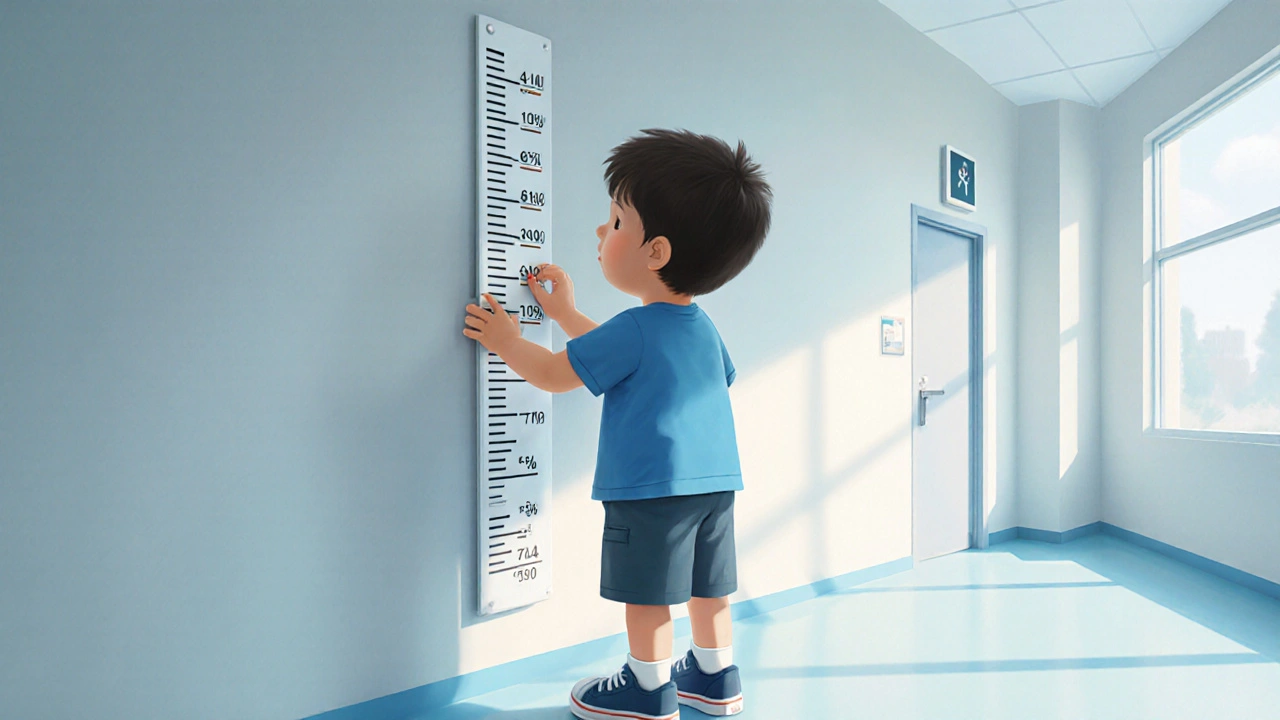13 Oct 2025
- 20 Comments
Growth Velocity Calculator for Children
This tool helps parents and caregivers assess whether a child's growth rate might indicate abnormal growth hormone activity. The article explains that growth exceeding 4-5 inches per year is a key indicator of potential acromegaly in children.
Growth Velocity Results
Key Takeaways
- Acromegaly in children is caused by excess growth hormone, usually from a pituitary adenoma.
- Early signs include rapid height growth, enlarged hands/feet, and facial changes.
- Diagnosis relies on hormone labs (IGF‑1) and imaging such as MRI.
- Treatment options include surgery, somatostatin analogs (Octreotide, Lanreotide), and GH‑receptor blockers (Pegvisomant).
- Lifelong monitoring by a pediatric endocrinologist is essential for growth control and quality of life.
When a child suddenly shoots up on the growth chart, parents often wonder if it’s a temporary growth spurt or something more serious. Acromegaly in children is a rare condition where the body produces too much growth hormone (GH) before the growth plates close. The excess GH drives abnormal tissue growth, leading to what doctors call pediatric gigantism. If caught early, treatment can keep the child’s height within a normal range and prevent long‑term complications.
What Exactly Is Acromegaly in Children?
Growth hormone excess is the core problem. In most cases a pituitary adenoma, a benign tumor in the pituitary gland, secretes GH continuously. The hormone then stimulates the liver to produce Insulin‑like growth factor 1 (IGF‑1), the messenger that actually fuels bone and tissue growth.
Because children’s growth plates are still open, the extra GH causes them to grow taller than expected-sometimes more than 4‑5 inches in a single year. As the bones lengthen, soft tissues also enlarge, leading to characteristic facial and body changes.
Recognizing the Signs & Symptoms
Parents are the first detectives. Here’s what to watch for:
- Accelerated growth velocity: Height increasing faster than the 97th percentile.
- Enlarged hands and feet-shoes may need a larger size every few months.
- Coarse facial features: enlarged nose, protruding jaw (prognathism), and thickened lips.
- Excessive sweating and oily skin.
- Headaches or visual disturbances, especially peripheral vision loss.
- Joint pain or stiffness from rapid bone growth.
These clues often appear before age 10, but the exact age varies. If multiple symptoms line up, it’s time to see a pediatric endocrinologist.

How Doctors Diagnose the Condition
The work‑up starts with a detailed history and physical exam, followed by lab tests and imaging.
- Hormone testing: Blood levels of IGF‑1 are measured first because they remain elevated throughout the day. If IGF‑1 is high, an oral glucose tolerance test checks GH suppression; lack of suppression confirms excess GH.
- Imaging: A magnetic resonance imaging (MRI) of the brain visualizes the pituitary region. MRI can pinpoint the size and exact location of the adenoma, which helps plan surgery.
- Additional studies: In some cases, X‑rays of the hand and wrist assess bone age, and visual field tests detect optic nerve involvement.
All these steps usually happen over a few weeks, allowing the medical team to confirm the diagnosis and map out a treatment plan.
Treatment Options: What’s Available and When to Use Them
Managing pediatric acromegaly is a team effort involving neurosurgeons, endocrinologists, and radiologists. The goal is to normalize GH/IGF‑1 levels, stop abnormal growth, and preserve vision.
Surgical Removal
Transsphenoidal surgery-accessing the tumor through the nose-is the first‑line approach for most children with a well‑defined adenoma. A skilled neurosurgeon can remove up to 80‑90% of the tumor in one go. Success rates are higher when the tumor is small (<1cm) and not invasive.
Medication Therapy
If surgery isn’t possible, only removes part of the tumor, or GH levels stay high afterward, medications step in.
| Medication | Type | How it works | Typical dosing (children) | Key pros | Common side effects |
|---|---|---|---|---|---|
| Octreotide | Somatostatin analog | Blocks GH release from the pituitary | 10‑30µg/kg SC twice daily or long‑acting depot monthly | Rapid GH reduction, injectable depot reduces frequency | Abdominal pain, gallstones, mild glucose intolerance |
| Lanreotide | Somatostatin analog | Similar to Octreotide, longer half‑life | 30‑60mg SC every 4weeks | Fewer injections, good for adherence | Injection site reactions, diarrhea |
| Pegvisomant | GH‑receptor antagonist | Blocks GH action on peripheral tissues | 10‑30mg SC daily | Normalizes IGF‑1 even when surgery fails | Elevated liver enzymes, injection site pain |
Choosing the right drug depends on tumor size, side‑effect tolerance, and how quickly GH levels need to be controlled. Some children start on a somatostatin analog and switch to Pegvisomant if IGF‑1 stays high.
Radiation Therapy
When surgery and medication can’t fully control the disease, focused radiation-either conventional stereotactic or newer proton beam-can shrink residual tumor tissue. The downside is a delayed effect (often 1‑3years) and a risk of hypopituitarism, so it’s reserved for refractory cases.
Living with the Condition: Follow‑Up and Everyday Tips
Even after the tumor is removed or medication normalizes hormones, children need regular monitoring:
- Hormone panels every 3‑6months to keep IGF‑1 in the age‑adjusted range.
- Growth tracking at each pediatric visit-watch for any sudden spikes.
- Vision checks annually, especially if the tumor was close to the optic chiasm.
- Bone density tests if long‑term medication is used, as some drugs affect calcium metabolism.
Psychosocial support matters, too. Kids may feel self‑conscious about their size or facial changes. Engaging a child psychologist or support group can ease anxiety and improve school performance.

Prognosis and Outlook
When diagnosed before the growth plates close, early intervention can keep final adult height within two standard deviations of the mean. Long‑term studies show that children who achieve normal IGF‑1 levels have similar life expectancy to their peers, though they may need hormone replacement if pituitary function declines.
Key factors influencing outcome:
- Age at diagnosis-earlier is better.
- Completeness of tumor removal.
- Responsiveness to medication.
- Adherence to follow‑up schedule.
With a dedicated care team, most families report a good quality of life, active participation in sports, and successful transition to adult endocrinology care.
Quick Checklist for Parents
- Track growth on a chart and note any rapid changes.
- Watch for enlarged hands/feet and facial changes.
- Ask your pediatrician for an IGF‑1 test if you suspect a problem.
- Ensure your child sees a pediatric endocrinologist for confirmatory testing.
- Discuss all treatment options-including surgery, medication, and radiation-with the specialist.
- Schedule regular hormone and vision follow‑ups.
Early detection saves a lot of hassle down the road. If you notice any of the red‑flag signs, don’t wait-talk to your doctor today about Acromegaly in children. A swift, coordinated plan can keep your child’s growth on track and their future bright.
Frequently Asked Questions
Can acromegaly in children cause early puberty?
Yes. Excess growth hormone can stimulate the adrenal glands and gonads, leading to earlier onset of secondary sexual characteristics. Monitoring hormone panels helps detect this early.
Is surgery curative for all cases?
Surgery removes the tumor in many children, especially when it’s small and well‑encapsulated. However, larger or invasive adenomas may leave residual tissue, requiring medication or radiation.
How long will a child need medication?
Medication is often continued until the growth plates close and IGF‑1 stays normal without intervention. Some children stay on a low dose for several years; others can stop after successful surgery.
Are there lifestyle changes that help control the disease?
A balanced diet and regular exercise support overall health but do not directly lower GH. However, maintaining a healthy weight can reduce the risk of insulin resistance, a common side effect of some treatments.
What is the long‑term outlook for vision problems?
If the tumor compresses the optic chiasm, vision loss can be permanent. Prompt surgical decompression often restores or preserves vision, but regular eye exams remain crucial.


Camille Ramsey
October 13, 2025If you think that over‑growing a kid is merely a cosmetic issue, you’re grossly misreading the biology; the pituitary gland’s unchecked secretion of GH spawns systemic complications-cardiovascular strain, insulin resistance, and joint pain-that no amount of aesthetic tolerance can excuse. In truth, the adage "size matters" becomes a literal health crisis when the scaffold of the skeleton expands unchecked. Moreover, the language you use when describing such conditions should match the gravity of the pathology, not a casual shrug. People often definately overlook early signs because they think a tall child is just "blessed" with good genes.
Raghav Narayan
October 14, 2025When a child’s growth velocity surpasses the typical four‑to‑five‑inch‑per‑year threshold, clinicians should initiate a comprehensive endocrine evaluation without delay. First, a detailed growth chart spanning the preceding two years is indispensable; it establishes the velocity curve and highlights any acceleration. Second, serum insulin‑like growth factor‑1 (IGF‑1) and insulin‑like growth factor‑binding protein‑3 (IGFBP‑3) levels provide a reliable surrogate for growth hormone excess, as they remain elevated in the majority of affected individuals. Third, an oral glucose tolerance test (OGTT) remains the gold standard: a failure of growth hormone to suppress below 1 ng/mL after a 75‑gram glucose load confirms autonomous secretion. If biochemical evidence supports the diagnosis, magnetic resonance imaging of the sellar region must follow promptly to delineate adenomatous size, invasiveness, and potential cavernous sinus involvement. Surgical resection, preferably via a transsphenoidal approach, offers the best chance for long‑term remission, especially for microadenomas under one centimeter. For macroadenomas or residual disease, adjunctive radiotherapy or medical therapy with somatostatin analogues, dopamine agonists, or growth hormone receptor antagonists become necessary. Importantly, patients require lifelong monitoring of IGF‑1, visual fields, and pituitary function because recurrence can occur many years after initial treatment. In the pediatric population, preserving near‑normal growth potential while preventing comorbidities such as cardiomegaly and glucose intolerance is a delicate balance that necessitates a multidisciplinary team comprising endocrinologists, neurosurgeons, radiologists, and pediatricians. Early intervention not only safeguards physical health but also mitigates psychosocial distress associated with abnormal stature, which can profoundly impact self‑esteem and peer relationships. Families should be counseled about the genetic underpinnings, as certain familial isolated pituitary adenoma syndromes predispose to earlier onset. Finally, supportive resources-including patient advocacy groups and counseling services-play a pivotal role in navigating the challenges of diagnosis, treatment, and long‑term follow‑up.
Tara Phillips
October 15, 2025Let us consider the profound responsibility borne by caregivers when confronted with a child's accelerated growth; the very act of measurement becomes a solemn covenant to safeguard health. I therefore implore you to employ the calculator with diligence, recording each datum meticulously, for in those numbers lies the potential to avert far‑greater adversity.
Derrick Blount
October 16, 2025Indeed, the very notion of unchecked somatic expansion, while seemingly a triumph of nature, betrays an ontological paradox, for growth unmoored from regulation becomes, paradoxically, a regression toward pathology; therefore, one must, with rigorous scrutiny, interrogate each metric, each hormonal datum, and each radiographic silhouette, lest we succumb to the illusion of benign hypertrophy, and overlook the insidious encroachment upon vascular, metabolic, and skeletal equilibrium.
Priya Vadivel
October 16, 2025I hear the urgency in your discourse, and I appreciate the meticulous framing; however, it may serve the community better to temper the rhetorical intensity with a gentle reminder that families often grapple with fear and uncertainty, and that a compassionate, step‑by‑step explanation can illuminate the path forward without overwhelming them.
Dharmraj Kevat
October 17, 2025Growth numbers don’t lie.
Lindy Fujimoto
October 18, 2025✨ Wow, those digits are screaming 🚨 ⚡️-it’s like your kid’s a secret superhero in training! But seriously, those rapid gains are a red flag 🚩, so grab the calculator, punch in the numbers, and let’s keep the cape‑wearing dreams safe from any hidden villains. 🌟💪
darren coen
October 19, 2025That tool is straightforward and helps catch issues early.
Jennifer Boyd
October 20, 2025Absolutely! A quick check can be a game‑changer for families, turning uncertainty into empowerment and giving kids the healthiest future possible.
Lauren DiSabato
October 21, 2025One must question whether the layperson truly comprehends the nuance behind a mere “four‑to‑five‑inch” metric; the casual observer, enamored by sensational headlines, often neglects the myriad endocrine intricacies that underlie such a figure, thereby reducing a complex pathophysiology to a simplistic footnote.
Hutchins Harbin
October 21, 2025I get what you’re saying, but it’s worth noting that while the numbers provide a baseline, clinicians also consider familial patterns, BMI trends, and even psychosocial factors before jumping to conclusions.
Benjamin Herod
October 22, 2025Well, another day, another over‑the‑top growth chart-guess we’ll just watch the drama unfold while the pituitary throws a party.
luemba leonardo brás kali
October 23, 2025While the narrative may sound theatrical, the clinical implications are far from trivial; a balanced, evidence‑based approach remains essential.
Corey McGhie
October 24, 2025Look, the calculator’s a neat side‑kick, but the real hero is a multidisciplinary team that can translate those numbers into actionable care-sarcasm aside, collaboration saves lives.
Ajayi samson
October 25, 2025Honestly, the whole “growth velocity” craze is just a buzzword to sell more gadgets-people need to stop over‑complicating a simple metric.
Ogah John
October 25, 2025Ah, the paradox of progress: we quantify growth yet sometimes forget the human story behind each datum, a reminder that science and compassion must walk hand‑in‑hand, even when sarcasm tempts us.
Kelvin Murigi
October 26, 2025Exactly-while we crunch the figures, let’s also remember that early intervention can transform a potentially daunting prognosis into a narrative of resilience, empowering families with clear, evidence‑driven steps.
ahmad matt
October 27, 2025Sure, but don’t pretend the calculator isn’t just a shiny toy to distract from the fact that most parents will ignore it anyway-if they cared, they’d already be in a clinic.
kristine ayroso
October 28, 2025Yo, stop the shade! The tool is legit and can really help-yeah, people might skip it, but that’s on them, not the calculator. Let’s spread the word, not the sarcasm.
Ben Small
October 29, 2025Let’s fire up that calculator, smash those numbers, and keep those kids growing strong-no time for hesitation!